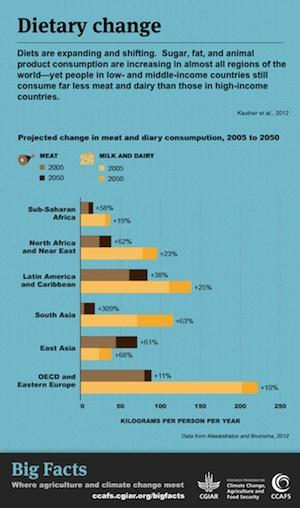At UN Climate Talks, Researchers Insert Facts on How Food Is Driving—and Is Driven by—Climate Change
Food waste responsible for up to 10 percent of global emissions; biofuels may not reduce greenhouse gases; agriculture has potential to sequester millions of tonnes of carbon each year, included in “Big Facts”
DOHA (30 November 2012)—Applying scientific answers to the consumer question, “What do our food choices have to do with heat, hurricanes, floods, and droughts?”, the CGIAR Research Program on Climate Change, Agriculture and Food Security (CCAFS) is launching today a set of “Big Facts” that highlight the complex relationship between agriculture and climate change. This effort illustrates not only the profound and diverse impacts of the changing climate on marine fisheries, livestock, forests, biodiversity and food crops but also the effects of agricultural activities, including emissions from biofuel production, on climate change.
The suite of 30 key facts, featuring infographics and compelling photographs from the field, cover everything from undernourishment and population to forestry and fisheries—integrating the latest and most authoritative research on relevant topics. To avoid oversimplification of complex issues and to provide additional information, a sub-set of facts supports each “Big Fact.” The result: a one-stop, scientific source for facts about climate change, agriculture and food security.
“ It is well understood that climate change has an enormous impact on what we can grow and eat. Conversely, the global food system—from production to transportation and refrigeration—emits up to a third of human-generated greenhouse gases. But with so much information about climate change available, it’s difficult to know what the key facts are,” said Sonja Vermeulen, the head of research at CCAFS and leader of the “Big Facts” initiative. “We scoured the latest research to identify the best and most current scientific knowledge. The result is a set of need-to-know facts that quickly and accurately crystalize the undeniable relationship between climate change and food security.”
It is well understood that climate change has an enormous impact on what we can grow and eat. Conversely, the global food system—from production to transportation and refrigeration—emits up to a third of human-generated greenhouse gases. But with so much information about climate change available, it’s difficult to know what the key facts are,” said Sonja Vermeulen, the head of research at CCAFS and leader of the “Big Facts” initiative. “We scoured the latest research to identify the best and most current scientific knowledge. The result is a set of need-to-know facts that quickly and accurately crystalize the undeniable relationship between climate change and food security.”
When taken together, the “Big Facts” reveal in stark terms the sweeping impacts—some positive but most negative—of the changing climate on farmers, fishers and other food producers, as well as on poor people who struggle to eat even now, before climate change has completely taken hold. They also underline agriculture’s sizeable contribution to greenhouse gas emissions.
As a leader in the climate change and food security field, CCAFS used its own research as a source of many “Big Facts.” Two major research papers released by CCAFS last month, for example, shed new light on the impact of climate change on agriculture—and vice versa. One report looked at the potential impact of climate change on 22 of the world’s most important food crops. The second estimated the food system’s total contribution—up to 29 percent, possibly more than energy generation—to global greenhouse emissions.
Some of the other striking facts include:
- Food waste: Roughly one-third of food produced for human consumption, about 1.3 billion tonnes per year, gets lost or wasted globally—the equivalent of 6 to 10 percent of human-generated greenhouse gas emissions.
- Impacts on water: By 2050, climate change will increase extreme drought, especially in the subtropics and low and mid-latitudes. Increased water stress will impact land areas twice the size of those areas that will experience decreased water stress.
- Dietary change: South Asia will quadruple its meat consumption from 2005 to 2050. Despite these changes, its per capita meat consumption will be one-fifth of consumption in high-income nations.
- Reduced deforestation: The economic potential of global forestry mitigation options is estimated to be between 1,270 and 4,230 million metric tonnes of carbon dioxide equivalent (MtCO2e) per year in 2030 (at carbon prices up to USD 100 per tonne of CO2e). Achieving about half of this mid-range estimate would cost less than US 20 per tonne of CO2e.
- Livestock emissions: The global livestock sector emits almost 6,000 MtCO2e per year at 2008 levels and accounts for about 11 percent of global greenhouse gas emissions. Emissions from the sector are expected to increase 70 percent by 2050.
“The urgent need for the United Nations and its member countries to help farmers adapt to and mitigate climate change is clear. But policymakers need to start with the facts. After all, policies born from misinformation can be just as damaging or ineffective as no policies at all,” said Bruce Campbell, CCAFS program director. “These facts, which will be continually updated as new research comes in, serve as an invaluable resource for anyone navigating the climate change-food security nexus.”
In a push for policy action on climate change and food security at the Doha meeting, CCAFS is working with many of the world’s leading agricultural agencies, farmers’ groups and policy makers to convene Agriculture, Landscapes and Livelihoods Day on 3 December. The event will bring together the natural resource and agriculture community to share solutions for climate change adaptation and mitigation in agricultural landscapes with the aim of informing the UNFCCC negotiations.